Palermo is a beautiful city in Italy, renowned for its stunning architecture, vibrant culture, and diverse wildlife. Among the wildlife, birds are an especially prominent presence in Palermo.
The city is home to a variety of species that can be found living in its parks, green spaces, and waterside areas. From the iconic white storks to the colorful hoopoes, Palermo’s bird population is a delight to explore.
Whether you’re an experienced birdwatcher or simply an admirer of feathered creatures, Palermo is a great place to observe and appreciate birds in all their splendor.
1. Common Swift
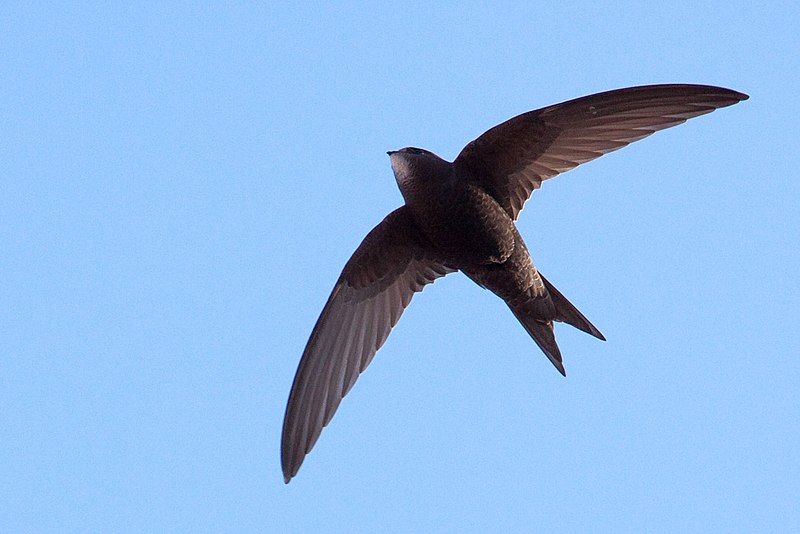
The common swift is a medium-sized bird that bears a strong resemblance to the barn swallow or the house martin. Despite their similarities, these species do not stem from the same family.
The common swift is part of the order of Apodiformes, whereas barn swallows and house martins are part of the passerine family. This similarity between these three species is a result of convergent evolution.
Convergent evolution occurs when two unrelated species develop similar features due to similar environmental conditions. In this case, the common swift, barn swallow, and house martin all adapted to similar conditions, resulting in similar physical features.
These species have evolved similar traits as a result of living in similar environments, which explains their similarities despite being from different families.
| Kingdom | Animalia |
| Phylum | Chordata |
| Class | Aves |
| Clade | Strisores |
| Order | Apodiformes |
| Family | Apodidae |
| Genus | Apus |
| Species | A. apus |
2. Common Wood Pigeon
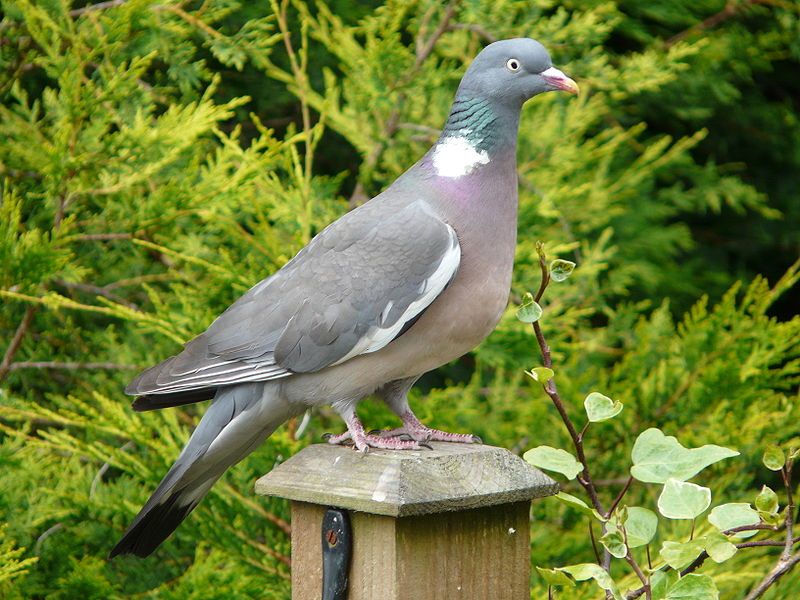
The common wood pigeon is a large bird species that is part of the dove and pigeon family. It is native to the western Palearctic, which is a region that encompasses parts of Europe, North Africa, and the Middle East.
This bird belongs to the genus Columba, which is a group of closely related species such as the rock dove. The common wood pigeon is a plump bird with a distinctive white patch on its neck, and it can be found in cities, woodlands, and farmland.
It feeds on seeds, berries, and plants, and it is a popular game bird due to its size. The wood pigeon is also known to nest in tall trees and is a common sight in gardens across Europe. In addition, these birds are known to make loud cooing noises to attract a mate.
| Kingdom | Animalia |
| Phylum | Chordata |
| Class | Aves |
| Order | Columbiformes |
| Family | Columbidae |
| Genus | Columba |
| Species | C. palumbus |
3. Common Cuckoo
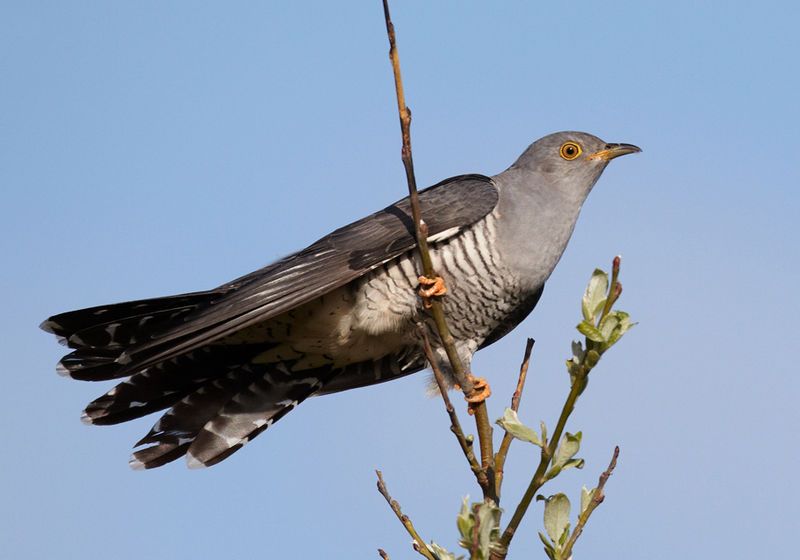
The common cuckoo is a bird species belonging to the Cuculiformes order, which is a group of birds that includes some well-known species such as roadrunners, anis, and coucals.
This particular species is found in many parts of Europe and Asia during the summer months and migrates to Africa when winter comes.
Its wide range is due to its adaptability and its ability to move to new regions in search of food. The common cuckoo has a unique call that helps it stand out from other birds. Its call is a loud “cu-coo” sound, which is a distinct feature of the species.
Its song also helps it attract mates and ward off predators.
It is also known to lay its eggs in other birds’ nests, a behavior known as brood parasitism. The common cuckoo is an important member of its habitat, as it helps maintain the balance of nature by eating a variety of insects, providing food for other animals, and helping to disperse seeds.
It also plays an important role in the local culture, with some cultures believing that the cuckoo is a symbol of good fortune. Overall, the common cuckoo is a fascinating species that is an important part of its environment and culture.
Its ability to migrate to different regions and its distinct call make it a unique species that is sure to continue to be a key part of the natural world.
| Kingdom | Animalia |
| Phylum | Chordata |
| Class | Aves |
| Order | Cuculiformes |
| Family | Cuculidae |
| Genus | Cuculus |
| Species | C. canorus |
4. Pallid Swift
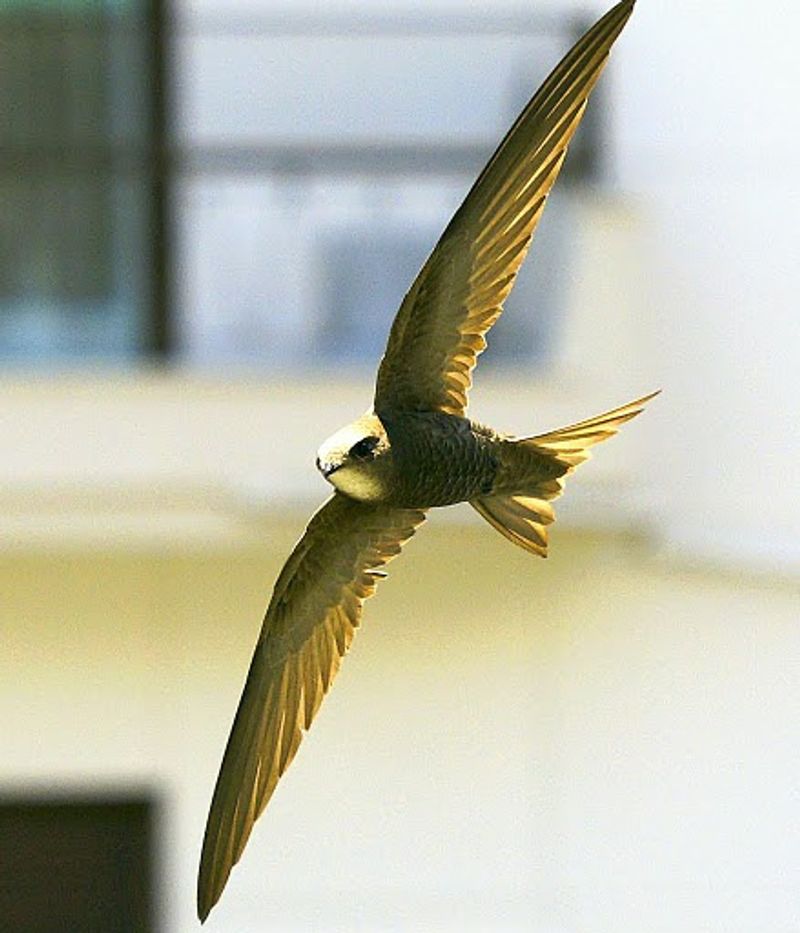
The pallid swift is a species of swift that belongs to the genus Apus, which is derived from a Latin word meaning “swift”. It has a distinctive pale coloring and is known for its very short legs which it primarily uses for clinging to vertical surfaces.
This bird is a notable example of the swift family, as it never voluntarily settles on the ground. Ancient people believed that swifts had no feet, so the Latin word pallidum, which means “pale”, was used to describe this species.
This species is an incredible creature with its adaptations to cling to surfaces, and its refusal to settle on the ground. It is an impressive example of the Swift family, and its unique characteristics make it stand out from the rest.
| Kingdom | Animalia |
| Phylum | Chordata |
| Class | Aves |
| Clade | Strisores |
| Order | Apodiformes |
| Family | Apodidae |
| Genus | Apus |
| Species | A. pallidus |
5. Rock Dove
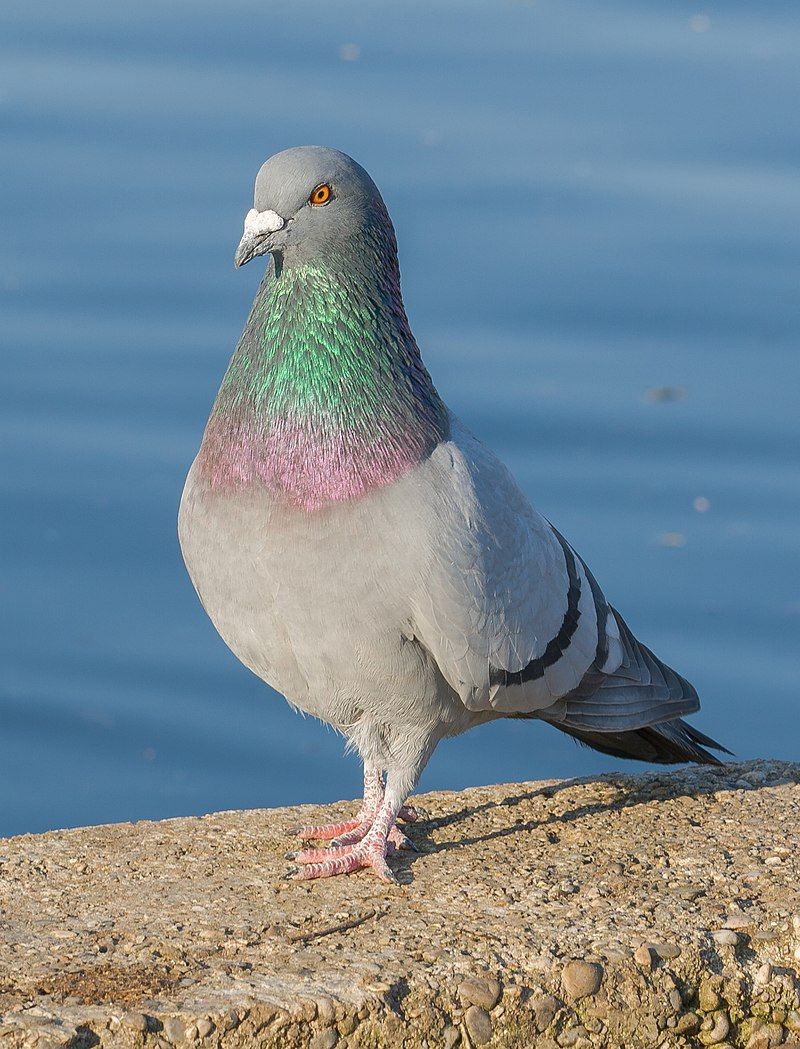
The rock dove, also known as the rock pigeon or common pigeon, is a species of bird that belongs to the Columbidae family. It is widely known simply as the “pigeon”.
The domestic pigeon is a direct descendant of the rock dove and has been domesticated as a pet or kept for its meat and eggs. As a result of escaped domestic pigeons, the populations of feral pigeons have grown significantly around the world.
Feral pigeons are basically wild-living descendants of escaped domestic pigeons, and they are often found in cities where they scavenge for food and build nests.
These pigeons are considered to be a nuisance to some people as they flock to areas that they find suitable for food and nesting.
| Kingdom | Animalia |
| Phylum | Chordata |
| Class | Aves |
| Order | Columbiformes |
| Family | Columbidae |
| Genus | Columba |
| Species | C. livia |
6. Great Crested Grebe
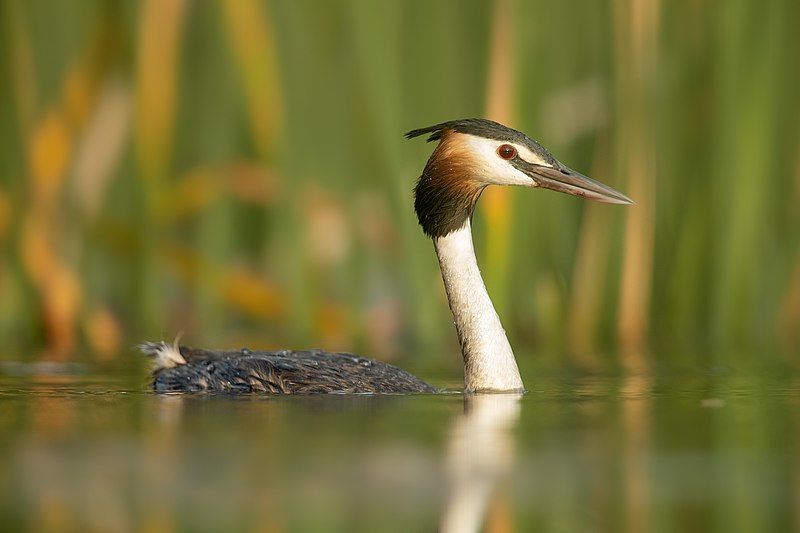
The great crested grebe is a species of bird native to Europe and parts of Asia. It is a member of the grebe family which is a group of water birds characterized by its lobed feet that are well adapted for swimming.
The great crested grebe is notable for its elaborate mating display which can be seen during the breeding season. The male will swim in a circle while displaying his white breast feathers and making a distinctive “whirring” sound.
The female will then join in the display, with the two birds swimming in unison and gently clapping their beaks together.
The display is typically accompanied by a variety of vocalizations and is thought to help the birds form a bond and increase the chances of successful mating.
Apart from the mating display, the great crested grebe is known for its striking appearance, with a black and white striped head, a brown back, and a red eye patch. Its diet consists mainly of fish, crustaceans, and aquatic insects.
| Kingdom | Animalia |
| Phylum | Chordata |
| Class | Aves |
| Order | Podicipediformes |
| Family | Podicipedidae |
| Genus | Podiceps |
| Species | P. cristatus |
7. Ferruginous Duck
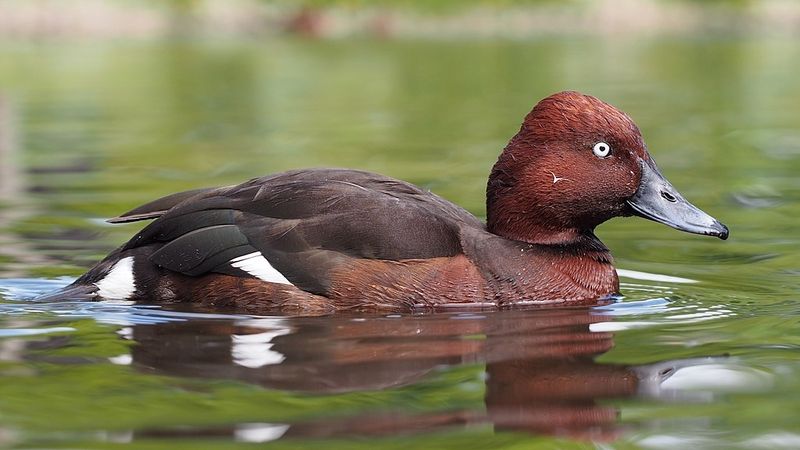
The ferruginous duck is a medium-sized diving duck that is found in Eurosiberia. It is also known by several other names, including ferruginous pochard, common white-eye, and white-eyed pochard.
Its scientific name is derived from two sources: the Greek word ‘aithuia’, which is an unidentified seabird mentioned by several authors such as Hesychius and Aristotle, and the Russian word ‘nyrok’, which refers to a duck. The ferruginous duck is a species of waterfowl that is mainly found in Eurasian wetlands.
It is a medium-sized duck, with a wingspan of up to 48 cm. Its head and neck are dark gray-brown in color, and it has a white eye-ring. It has a white breast and a dark brown back.
The male duck has a rusty-red head and neck, while the female’s head and neck are light brown. The ferruginous duck is a migratory species, and it breeds in large numbers in the wetlands of northern and central Europe.
It is a winter visitor to the Mediterranean basin and the Middle East. During the non-breeding season, it can be found in South and East Africa, South East Asia, and Australia. The ferruginous duck is an omnivore, feeding on aquatic invertebrates, plant material, and small fish.
It nests in shallow water, and lays its eggs in a shallow scrape on the ground.
The eggs are incubated by the female, and the young are able to fly within a few weeks. The ferruginous duck is listed as a species of Least Concern by the IUCN, as its population is believed to be stable.
However, it is threatened by habitat destruction and hunting and is not as widely distributed as it once was.
| Kingdom | Animalia |
| Phylum | Chordata |
| Class | Aves |
| Order | Anseriformes |
| Family | Anatidae |
| Genus | Aythya |
| Species | A. nyroca |
8. Common Pochard
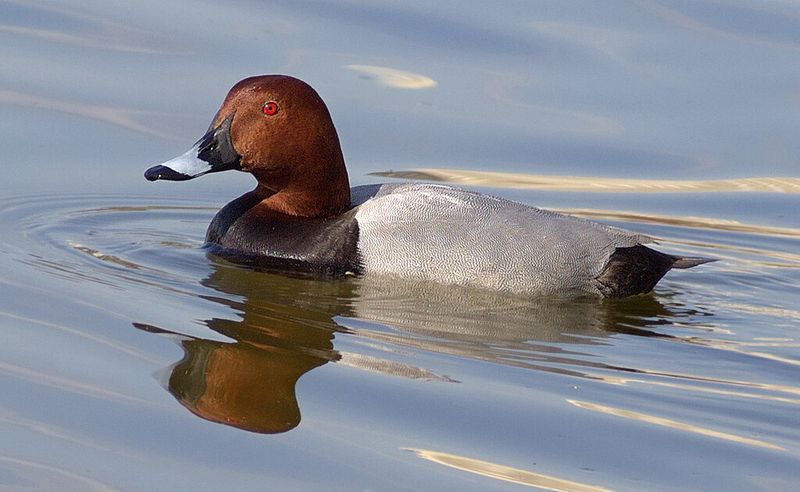
The common pochard is a medium-sized diving duck that is recognizable by its reddish-brown head and neck, white underparts, and black breast and wings. The scientific name for this species of duck is derived from two sources.
The first source is the Greek word “aithuia,” which refers to an unidentified seabird mentioned by ancient authors such as Hesychius and Aristotle.
The second source is the Latin word “ferina,” which translates to “wild game” and is derived from the word “ferus,” meaning “wild.” This scientific name is therefore reflective of the wild and mysterious nature of the common pochard.
The common pochard is a seasonal migrant, with different populations of the species appearing in different parts of the world at different times of the year.
It is a strong swimmer and can be found in both fresh and saltwater habitats, where it feeds on aquatic invertebrates and plant matter. It is a vocal species and can be heard making various calls such as a rasping quack.
The common pochard is an important species in its respective habitats, as it helps to maintain healthy aquatic ecosystems by preying on insects, fish, and plants.
| Kingdom | Animalia |
| Phylum | Chordata |
| Class | Aves |
| Order | Anseriformes |
| Family | Anatidae |
| Genus | Aythya |
| Species | A. ferina |
9. Stock Dove
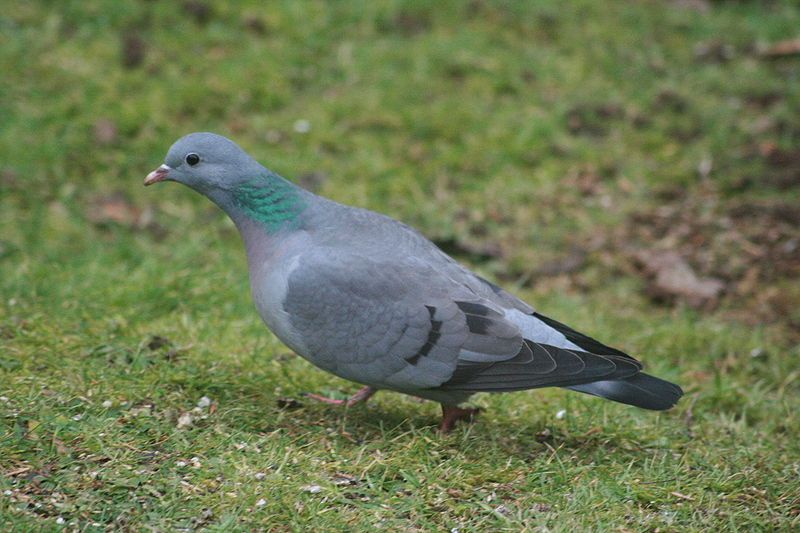
The stock dove is a type of bird that belongs to the family Columbidae, which also includes doves and pigeons. It is found throughout the western Palearctic region, which stretches from Europe, through North Africa, and to parts of Asia.
This species of bird is highly adaptable and can make its home in a variety of habitats, from woodlands to meadows.
It is a medium-sized bird, typically measuring from 29 to 36 centimeters in length, and is characterized by its grey-brown feathers and black-and-white barred wings.
The stock dove has a broad white band on its neck, with a black collar and white throat, and its head is a pale grey-brown. It is a social species, often found in groups, and is a vegetarian, feeding on grains, seeds, and other vegetation.
Its song is a low, mournful cooing, and it can be heard from a distance even in built-up areas. The stock dove is an important species in the natural ecosystem and is listed on the IUCN Red List as a species of least concern.
| Kingdom | Animalia |
| Phylum | Chordata |
| Class | Aves |
| Order | Columbiformes |
| Family | Columbidae |
| Genus | Columba |
| Species | C. oenas |
10. Common Coot
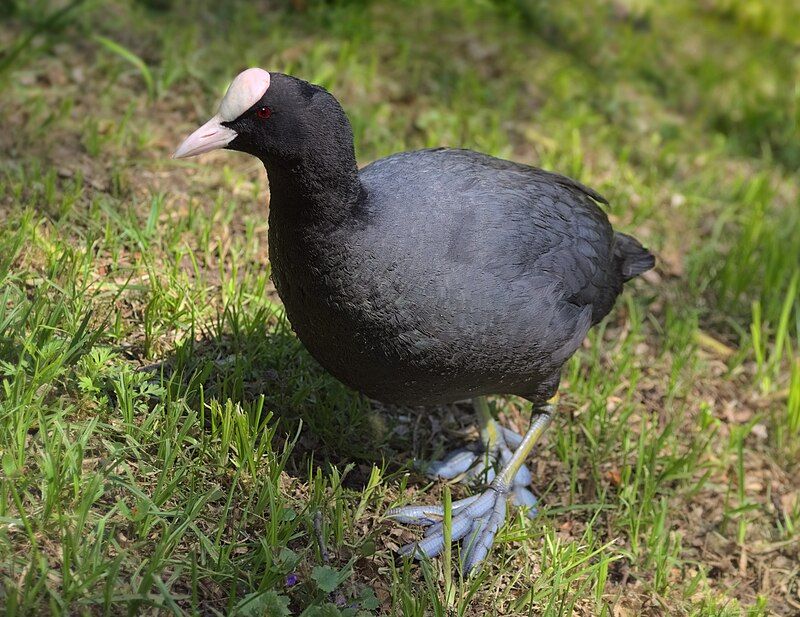
The Eurasian coot is a species of bird that belongs to the Rallidae family. It is native to many parts of the world, including Europe, Asia, Australia, New Zealand, and parts of North Africa.
This species of coot is easily recognizable for its slat-black body, glossy black head, and a distinctive white bill that features a white frontal shield. The Eurasian coot is a medium-sized bird, growing up to 16 inches in length.
It has short, thick legs that help it to walk on land, as well as a long, broad bill that it uses for foraging. This species of coot is an omnivore, feeding on both plants and small animals, such as mollusks, crustaceans, and aquatic insects.
This species of coot is also a strong swimmer, able to dive up to 22 feet in search of food. In the wild, the Eurasian coot is a gregarious species, often found in large flocks.
It prefers habitats such as marshes, ponds, and lake shores, where it makes its nest on the ground near the water’s edge. The Eurasian coot is a monogamous species, with pairs staying together for the duration of the breeding season.
During this time, the female lays around 8 eggs, which both parents take turns to incubate. The Eurasian coot is an important species in many parts of the world, and its population is currently stable.
However, this species is threatened by habitat destruction and pollution and is listed as Least Concern by the IUCN Red List of Threatened Species.
| Kingdom | Animalia |
| Phylum | Chordata |
| Class | Aves |
| Order | Gruiformes |
| Family | Rallidae |
| Genus | Fulica |
| Species | F. atra |
11. Common Shelduck
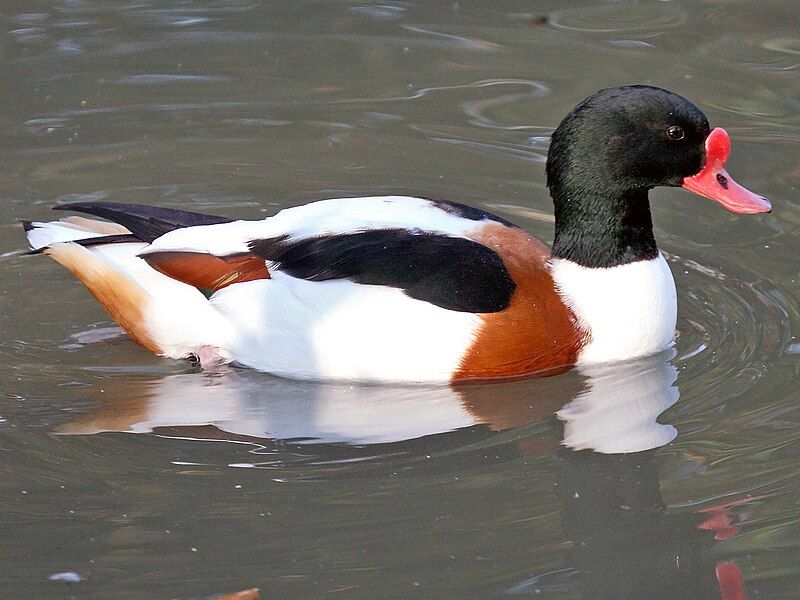
The common shelduck is a species of waterfowl belonging to the genus Tadorna. It is found in many parts of Europe and Siberia, and its range extends far into the Palearctic region.
This species breeds during the temperate months of the year and winters in subtropical regions, though it can also be seen occasionally in the Maghreb in the winter.
The common shelduck is a medium-sized bird, with a large, stocky body, a long, orange bill, and a black-and-white patterned head. They are gregarious animals, often found in large flocks, and they feed on aquatic plants, insects, worms, and mollusks.
They can also be seen swimming in shallow water, and they are often seen in marshes and estuaries. The common shelduck is an important species for conservation, as its large, healthy population helps to maintain the health of wetlands and other water ecosystems.
They are also an important species for hunters, as they provide a valuable source of food for many rural communities. In some parts of Europe, they are even kept as pets.
All in all, the common shelduck is an important species for many reasons and it is essential that it is protected and conserved.
| Kingdom | Animalia |
| Phylum | Chordata |
| Class | Aves |
| Order | Anseriformes |
| Family | Anatidae |
| Genus | Tadorna |
| Species | T. tadorna |
12. Rock Partridge
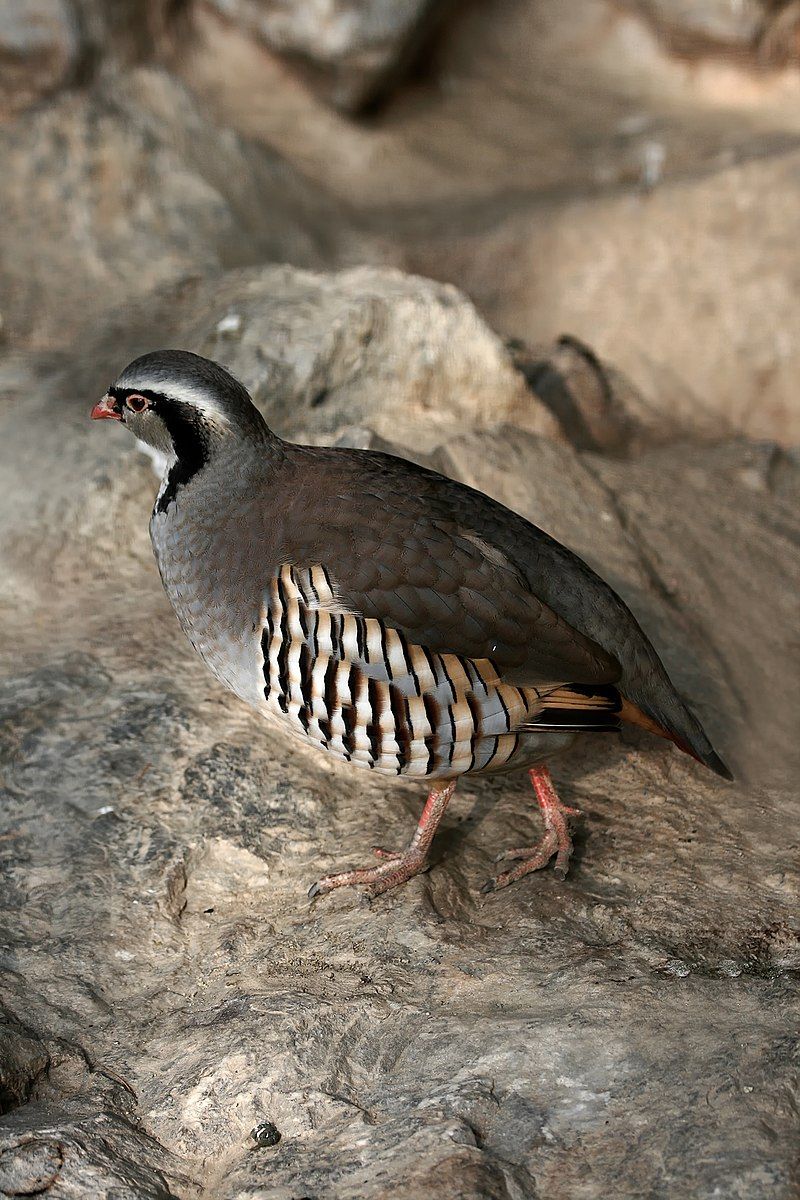
The rock partridge, also known as the common rock partridge, is a species of gamebird in the Phasianidae family of the order Galliformes. This species is native to southern Europe and is closely related to the chukar partridge, A. chukar, which is its eastern equivalent.
The rock partridge is similar in appearance to the chukar partridge but can be distinguished by its browner plumage, with white spots on the back and wings. The underside of the bird is creamy white, while the throat and head are brownish-black.
The beak of the rock partridge is yellowish-orange with a black tip. The tail of the rock partridge is short, with a white stripe running along the top. The feet are pinkish-red with yellowish-orange claws.
The rock partridge is a medium-sized bird, measuring around 35-45 cm in length. It is an omnivorous species, feeding on a variety of vegetation, insects, and small vertebrates.
In addition, the rock partridge is a popular gamebird amongst hunters, and its meat can be used in many dishes.
| Kingdom | Animalia |
| Phylum | Chordata |
| Class | Aves |
| Order | Galliformes |
| Family | Phasianidae |
| Genus | Alectoris |
| Species | A. graeca |
13. Common Crane
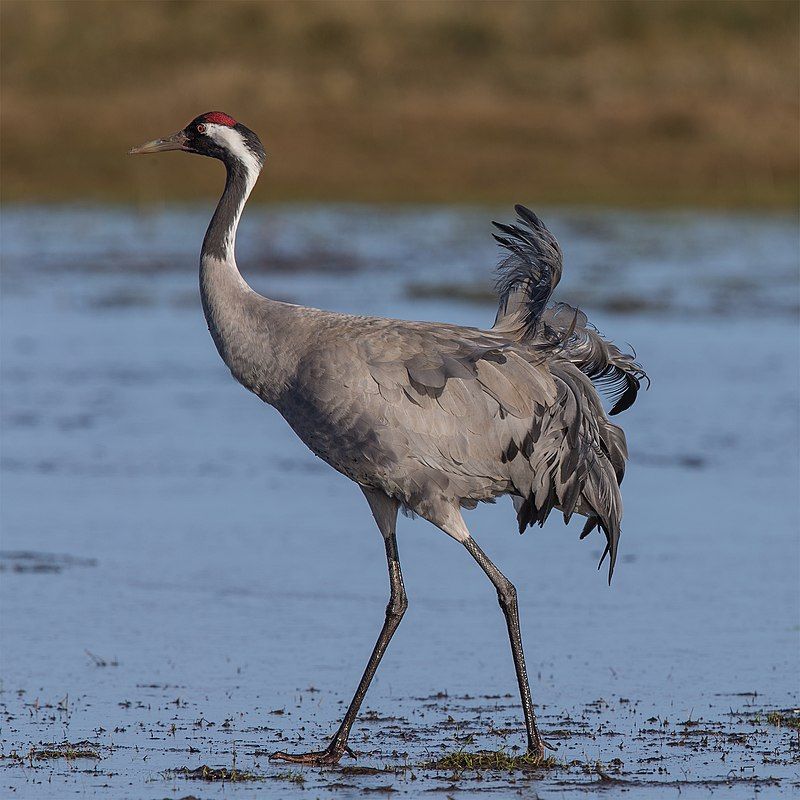
The Common Crane, also known as the Eurasian Crane, is a species of bird that belongs to the family of Gruidae, cranes. It is considered to be a medium-sized species, making it the only crane commonly found in Europe other than the Demoiselle Crane and the Siberian Crane.
The Demoiselle Crane is found in the western part of the continent, while the Siberian Crane is only found in the far eastern part of Europe. The Common Crane is an easily recognizable bird, with its tall stature and a wingspan of up to 2.2 meters.
It is usually gray or white in color, and its face has a prominent red patch which sets it apart from other species. The Common Crane is known to be a migratory species, as it can be seen in many parts of the world during the winter and summer months.
Its migratory range can be as far as Africa, and it is also known to travel to India, China, and even North America. The Common Crane is listed as a species of least concern by the International Union for Conservation of Nature, due to its large population and wide distribution.
However, its numbers have been declining due to the destruction of its wetlands habitats, and it is now considered to be a vulnerable species.
Conservation efforts have been put in place to help protect the species, such as the European Union’s Birds Directive, which has been successful in helping to increase the number of Common Cranes.
Overall, the Common Crane is an important species in Europe, and its conservation is essential for its survival. Its habitats must be protected, and measures must be taken to ensure that the species can continue to thrive on the continent.
| Kingdom | Animalia |
| Phylum | Chordata |
| Class | Aves |
| Order | Gruiformes |
| Family | Gruidae |
| Genus | Grus |
| Species | G. grus |
14. Common Moorhen
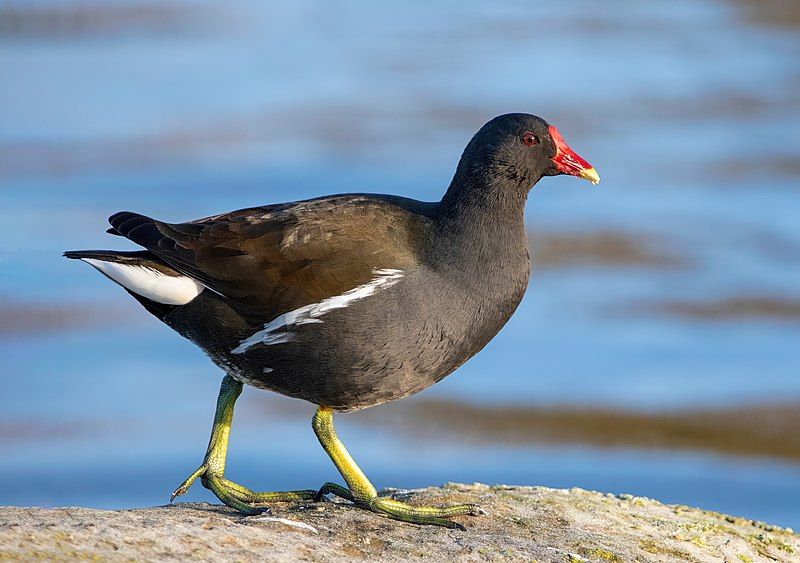
The Common Moorhen is a species of bird belonging to the rail family and is widely distributed across much of the Old World.
It is also known as the Waterhen or Swamp Chicken, due to the type of habitat it prefers. The Common Moorhen lives in and around well-vegetated wetlands, such as marshes, ponds, canals, and other wetland areas.
It is a highly adaptable bird, and can also be found in urban areas, such as parks and gardens. This species of bird feeds mainly on insects, but also on plant material, grains, and small fish. The Common Moorhen is a medium-sized bird, usually ranging from 25 to 30 cm in length.
It has dark-brown plumage with white underparts and a distinctive red shield on its forehead. It has a long, red bill and yellow legs. The Common Moorhen is a social creature, generally found in small groups or pairs.
During the breeding season, the males will perform courtship displays, such as head-bobbing and wing-flapping, in order to attract a mate.
The females build the nests and incubate the eggs, while the males defend the nesting site from predators. The Common Moorhen is an important species for wetland habitats, as it helps to control insect populations, and its droppings also provide vital nutrients to the ecosystem.
This species of bird is also an important game bird and is hunted in many parts of the world. Overall, the Common Moorhen is an interesting bird to observe and provides a valuable service to its wetland habitat.
| Kingdom | Animalia |
| Phylum | Chordata |
| Class | Aves |
| Order | Gruiformes |
| Family | Rallidae |
| Genus | Gallinula |
| Species | G. chloropus |
15. Black-winged Stilt
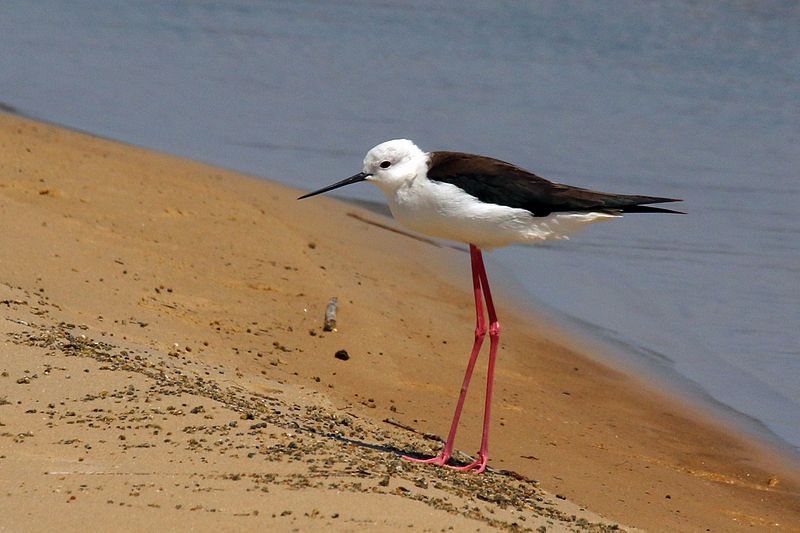
The black-winged stilt (Himantopus himantopus) is a species of long-legged wading bird in the avocet and stilt family. It is widely distributed across much of the world, with populations found on most continents except Antarctica. The scientific name for this species is H.
himantopus.
It is sometimes referred to as a single, cosmopolitan species, as it is found in a wide variety of habitats and is able to survive in different environmental conditions. The black-winged stilt typically stands between 18 to 21 inches tall, with a wingspan of about 32 inches.
It has a striking black and white plumage, with a long, thin black bill. Its legs are bright red or pink, and its feet are webbed, allowing it to easily navigate through shallow water.
It feeds mainly on insects, larvae, worms, and crustaceans, which it finds in shallow water or on wet mudflats. The black-winged stilt is a highly social species, often seen in large flocks. During the breeding season, it is quite territorial and will defend its nest vigorously.
The nest is usually built on the ground and consists of a shallow depression with a few twigs and grasses.
In the non-breeding season, the stilt may form larger flocks with other bird species, such as avocets, black-winged pratincoles, and redshanks. Overall, the black-winged stilt is a fascinating species of wading bird, which can be found in many parts of the world.
Its bright plumage and long legs make it a beautiful sight to behold. It is an important species, helping to control populations of small aquatic invertebrates, and is an important food source for other animals such as fish and shorebirds.
| Kingdom | Animalia |
| Phylum | Chordata |
| Class | Aves |
| Order | Charadriiformes |
| Family | Recurvirostridae |
| Genus | Himantopus |
| Species | H. himantopus |
16. Little Egret
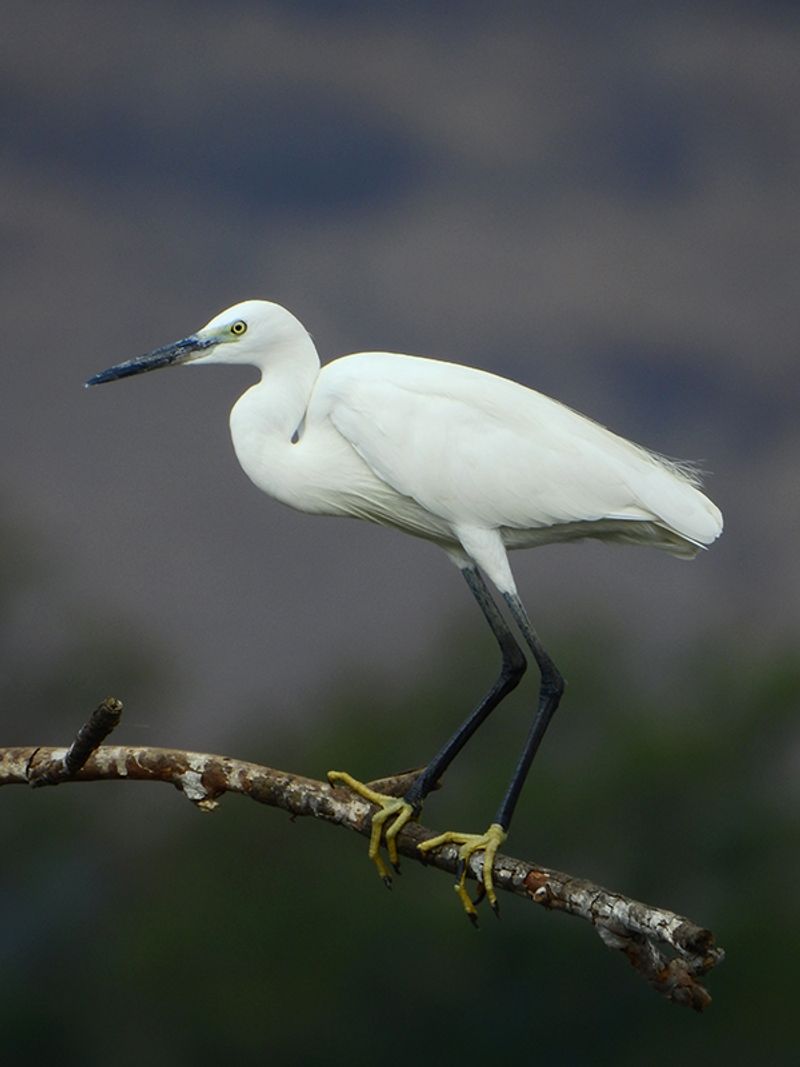
The little egret is a species of small white heron that is a part of the Ardeidae family. It has a slender black beak and long black legs, and in the western variety of the species, its feet are typically a bright yellow.
It is an aquatic bird, meaning it feeds both in shallow water and on land. Its diet consists of a variety of small creatures. The little egret is a graceful and beautiful bird, often seen in wetlands, parks, and other areas near water.
It is a popular bird among birdwatchers, due to its stunning appearance and its wide range of habitats.
| Kingdom | Animalia |
| Phylum | Chordata |
| Class | Aves |
| Order | Pelecaniformes |
| Family | Ardeidae |
| Genus | Egretta |
| Species | E. garzetta |
17. Yelkouan Shearwater
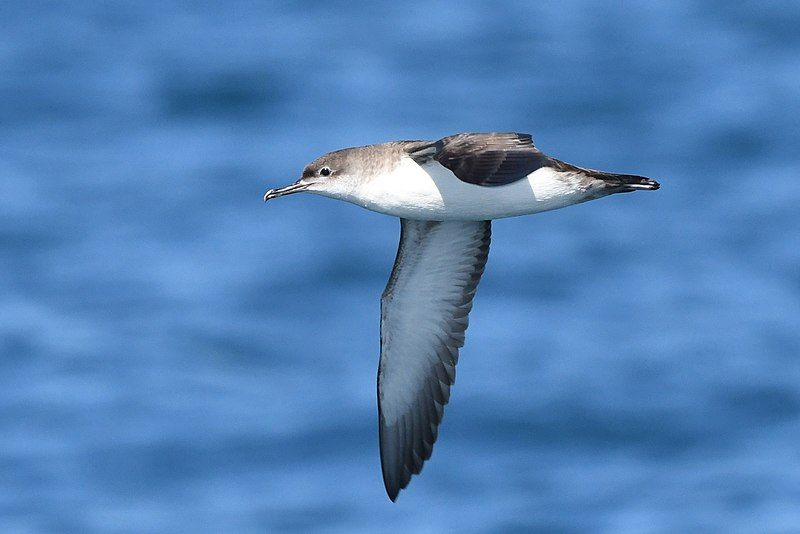
The yelkouan shearwater, also known as the Levantine shearwater or Mediterranean shearwater, is a seabird from the Procellariidae family. It is a medium-sized shearwater and has a wingspan of around 50-57 centimeters.
It is mainly found around the Mediterranean and Black Sea areas and is a fairly common bird in the region. Until recently, the yelkouan shearwater was considered to be a subspecies of the Manx shearwater, which is a large shearwater with a similar range.
However, recent studies have shown that the yelkouan has enough distinct characteristics to be considered a separate species. It is characterized by its blackish-brown upperparts, white underparts, and a distinctive white eyebrow.
Its flight is usually quite low and direct, and it is often seen flying in small flocks close to the surface of the sea. The yelkouan shearwater primarily feeds on small fish and crustaceans, which it catches by diving from the air into the sea.
It nests in burrows on coastal cliffs, and lays one single white egg.
The breeding season is usually from May to August, and the chicks fledge in around 60 days. Overall, the yelkouan shearwater is an interesting and important species in the Mediterranean region, and its distinct characteristics make it an important species to study and protect.
| Kingdom | Animalia |
| Phylum | Chordata |
| Class | Aves |
| Order | Procellariiformes |
| Family | Procellariidae |
| Genus | Puffinus |
| Species | P. yelkouan |
18. Ardea Alba
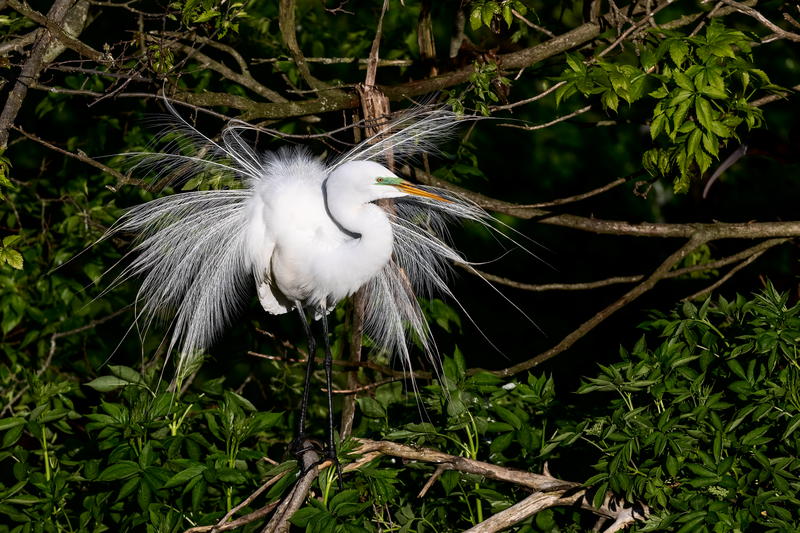
The great egret, also known as the common egret, large egret, or great white egret or great white heron, is a large bird species that can be found in a variety of different habitats.
It is found in Asia, Africa, the Americas, and southern Europe, and in recent years it has even begun to spread to more northern areas of Europe.
This species is highly adaptable, living in wetlands, marshes, estuaries, ponds, and even cultivated fields. The great egret has a long neck, long legs, and a slender body. It has white plumage, a yellow bill, and black legs and feet.
The great egret has a wingspan of up to five feet and can reach heights of up to four feet tall.
It is an opportunistic feeder, consuming a variety of prey such as fish, crustaceans, reptiles, amphibians, and insects. The great egret is an important part of many wetland ecosystems, as it helps maintain a balanced environment by controlling the population of its prey.
It is also an important indicator species, as its presence can indicate the health of a particular ecosystem. Unfortunately, this species is threatened by habitat loss and degradation, as well as the use of certain pesticides that can reduce their food supply.
Despite these threats, the great egret is still relatively common and is listed as a species of least concern by the IUCN.
| Kingdom | Animalia |
| Phylum | Chordata |
| Class | Aves |
| Order | Pelecaniformes |
| Family | Ardeidae |
| Genus | Ardea |
| Species | A. alba |
19. Purple Heron
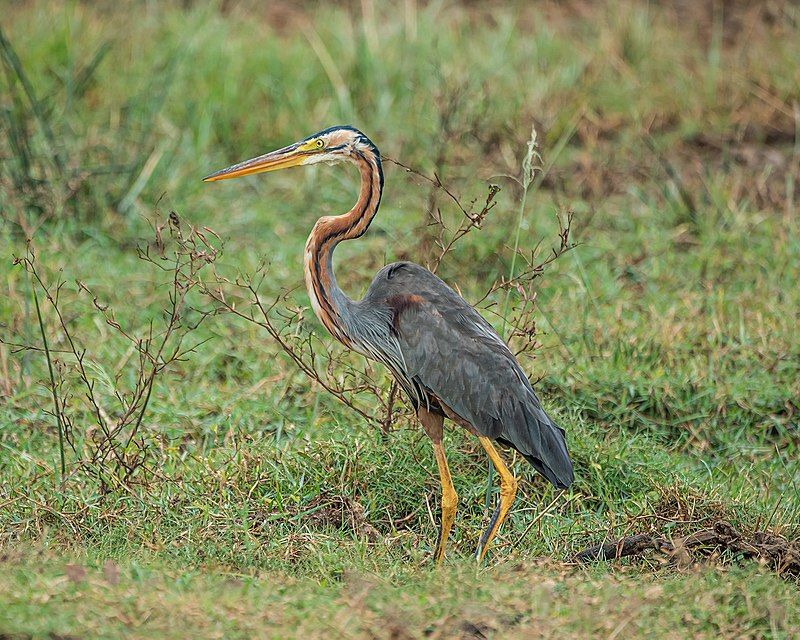
The purple heron is a species of wading bird that belongs to the heron family, Ardeidae. Its scientific name is derived from Latin, with ardea meaning “heron” and purpureus meaning “colored purple”.
This species of heron has a wide range of habitats, with populations breeding in Africa, central and southern Europe, and southern and eastern Asia. The purple heron is a large bird, with adults reaching up to 105 cm in length and a wingspan of 160 cm.
It has a long, slender neck and greyish-purple plumage, which gives it its name. The head is greyish-white, with a long, curved black bill and a white streak that runs down the center of the crown. The legs are yellowish-green.
This species of heron feeds mainly on fish, frogs, and aquatic invertebrates, using its long neck and bill to probe in shallow water or mudflats. It breeds in colonies, usually in trees or reedbeds and lays two to four pale blue eggs per clutch.
The purple heron is classified as a species of least concern on the IUCN Red List, though there are some populations that are threatened due to habitat destruction.
| Kingdom | Animalia |
| Phylum | Chordata |
| Class | Aves |
| Order | Pelecaniformes |
| Family | Ardeidae |
| Genus | Ardea |
| Species | A. purpurea |
20. Scopoli’s Shearwater
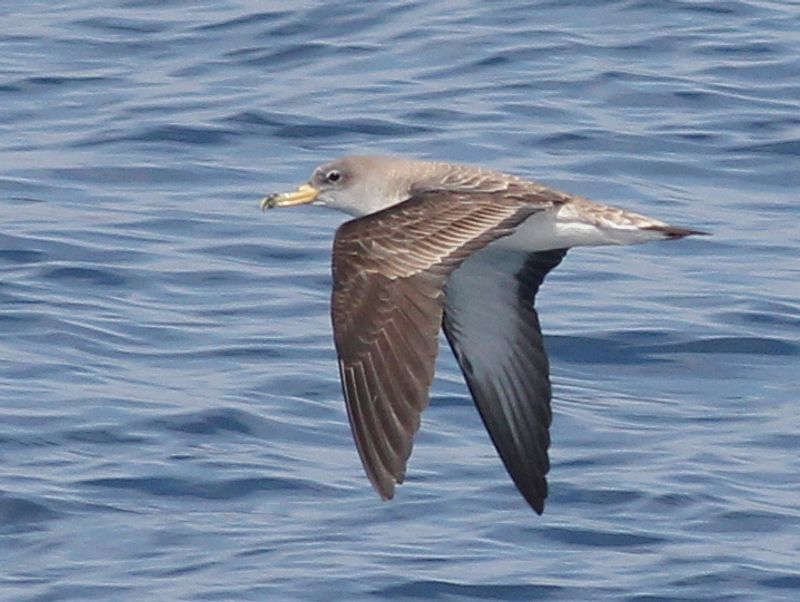
Scopoli’s shearwater is a species of seabird that belongs to the petrel family Procellariidae. It is mainly found in the Mediterranean region, where it breeds on rocky islands and steep coasts.
During the non-breeding season, the bird can be seen foraging for food in the Atlantic Ocean. The bird has a brownish-grey color on its upper side, with darker wings, and mostly white color on its underside. Its tail is long and pointed, and its wings are short and pointed.
It has a sharp, hooked beak which it uses to catch its prey. It is a fairly large bird and can reach a length of up to 44 cm. It is a strong flyer and can cover great distances during its migrations.
It is considered a highly endangered species, due to habitat destruction and human disturbance.
| Kingdom | Animalia |
| Phylum | Chordata |
| Class | Aves |
| Order | Procellariiformes |
| Family | Procellariidae |
| Genus | Calonectris |
| Species | C. diomedea |
21. Black-headed Gull
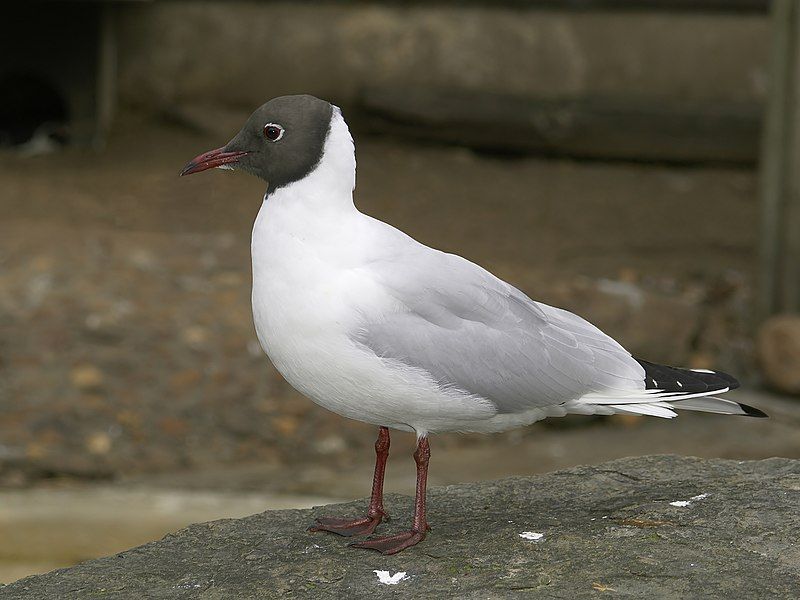
The black-headed gull is a species of small gull that breeds in many regions of the Palearctic, a biogeographic division of the Earth that includes Europe, northern Africa, and Asia. A large population of these gulls migrate seasonally and spend their winters further south.
However, some birds choose to stay in the milder environments of Western Europe, which allows them to remain in the region year-round.
This species is also found in coastal eastern Canada, which may be a result of recent migrations, or perhaps they were present in the region before the migratory population was established.
The black-headed gull is an important part of the local ecology, providing essential services such as scavenging and pest control. Additionally, they may act as indicator species, giving us insight into the health of a particular ecosystem.
As such, it’s important to monitor populations of this species and take appropriate action to ensure they remain stable and sustainable.
| Kingdom | Animalia |
| Phylum | Chordata |
| Class | Aves |
| Order | Charadriiformes |
| Family | Laridae |
| Genus | Chroicocephalus |
| Species | C. ridibundus |
22. Marbled Teal
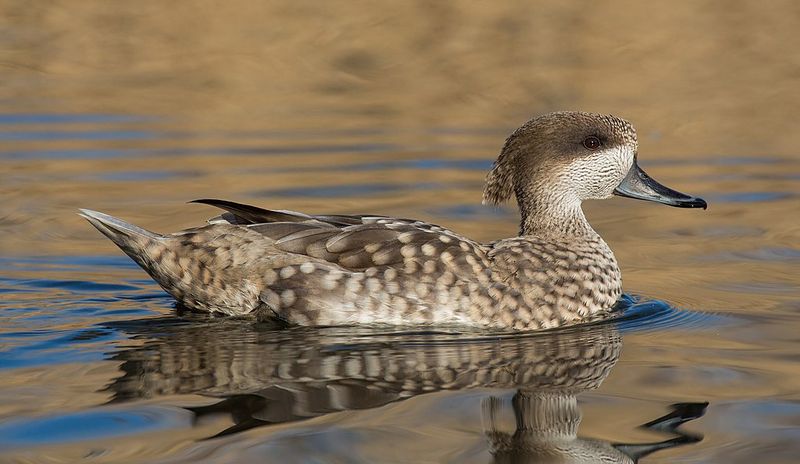
The Marbled duck (Marmaronetta angustirostris) is a species of duck that is native to Southern Europe, Northern Africa, and Western and Central Asia. It is a medium-sized species, with its scientific name coming from two separate languages.
The Greek portion, Marmaris and Netta, translates to “marbled duck,” an appropriate name due to the duck having a marbled pattern of coloring. The Latin portion of the name, Augustus and -rostris, translates to “narrow billed,” referring to the duck’s slender bill.
This species of duck is often found near bodies of water, such as lakes and rivers, and can be seen swimming, diving, and foraging for food. In addition, they are very social animals and often congregate in large groups.
The Marbled duck is an interesting species with a unique appearance, and it is important to help protect them from habitat destruction, pollution, and hunting.
| Kingdom | Animalia |
| Phylum | Chordata |
| Class | Aves |
| Order | Anseriformes |
| Family | Anatidae |
| Genus | Marmaronetta |
| Species | M. angustirostris |
23. Yellow-legged Gull
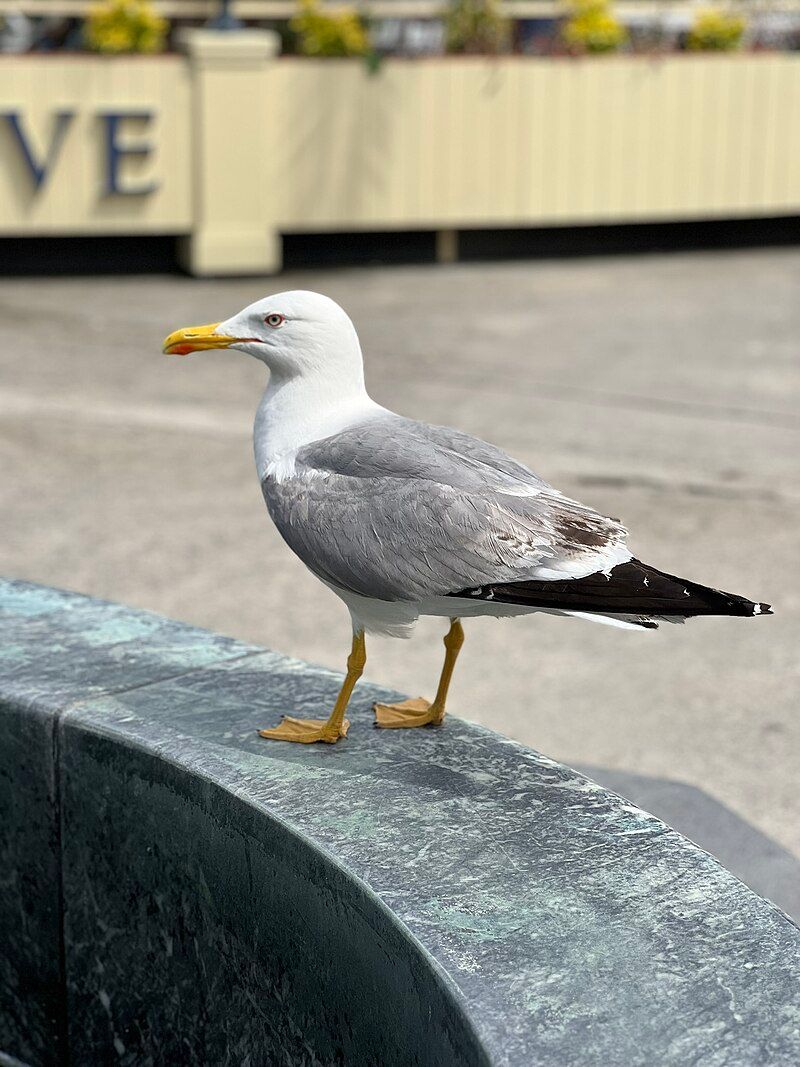
The yellow-legged gull (Larus michahellis) is a species of large gull found in Europe, the Middle East, and North Africa.
Recently, it has gained recognition as its own species, as it was formerly classified as a subspecies of the Caspian gull (Larus cachinnans) or the herring gull (Larus argentatus).
This species of gull is larger than other gulls, with a distinctive yellow leg and a grey-brown back. Its head and underparts are white, while its wings are tipped with black.
It is also notable for its sharp, hooked bill. The yellow-legged gull is often seen in coastal areas and open water, where it feeds on fish and small invertebrates. It will also scavenge food from landfills and human settlements.
This species is highly gregarious in the non-breeding season, often forming large flocks that can contain thousands of birds.
Breeding takes place in the spring and summer months, with pairs nesting on cliffs, rocky islands, and man-made structures. The yellow-legged gull can be found across a wide range of habitats, from the Mediterranean coast to the Russian steppes.
It is a relatively common species, though its population is facing a range of pressures due to human-driven habitat loss and degradation. Despite this, it is currently classified as a species of least concern by the International Union for Conservation of Nature.
| Kingdom | Animalia |
| Phylum | Chordata |
| Class | Aves |
| Order | Charadriiformes |
| Family | Laridae |
| Genus | Larus |
| Species | L. michahellis |
24. Great Bustard
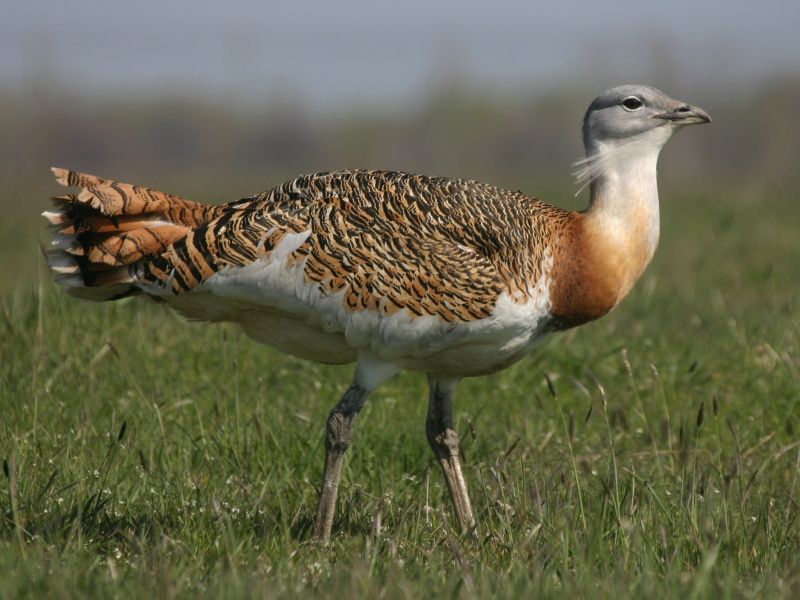
The great bustard is an impressive bird found in the bustard family. It is the only living species of the genus Otis, making it a unique species in the world. It is found in many areas, mainly open grasslands and farmland.
It is spread across a wide range of areas, from northern Morocco to Central and East Asia. These areas are generally temperate climates, which provide the bird with a suitable environment for breeding and thriving.
The great bustard is a large species of bird, with males reaching up to 4.5ft tall and weighing up to 40 lbs. It has a long neck and legs, giving it a unique appearance. Its feathers are generally brown and white, with some black and grey on the wings and tail.
It has a large bald head and a white ring of feathers around the neck. The great bustard feeds mainly on insects, seeds, and small mammals. It is often seen walking on the ground, looking for food.
It is also known to fly in search of food and has a distinctive short, powerful flight. The great bustard is an important species for conservation. It is listed as vulnerable by the IUCN and is protected by various international laws.
Its numbers are declining due to habitat loss and hunting, but efforts are being made to conserve and protect this species.
| Kingdom | Animalia |
| Phylum | Chordata |
| Class | Aves |
| Order | Otidiformes |
| Family | Otididae |
| Genus | Otis |
| Species | O. tarda |
Conclusion
Palermo is an ideal place to observe a wide variety of birds, from seabirds to songbirds. It is a great destination to explore bird life and appreciate the beauty of nature.
The city is home to a variety of birds, from flamingos to parrots, making it a great spot for nature lovers. With its diverse and vibrant birdlife, Palermo is a great destination for birdwatchers of all levels.